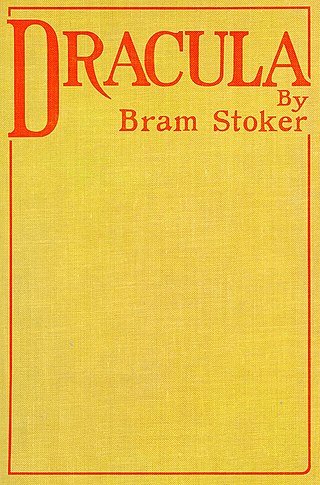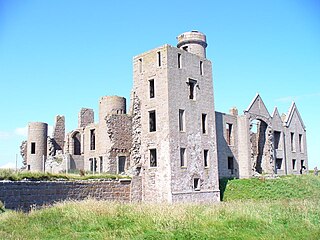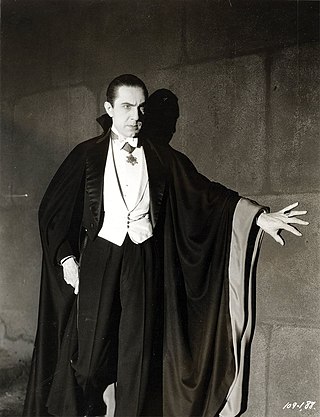
Abraham "Bram" Stoker was an Irish author who is best known for writing the 1897 Gothic horror novel Dracula. During his lifetime, he was better known as the personal assistant of actor Sir Henry Irving and business manager of the West End's Lyceum Theatre, which Irving owned.

Dracula is a gothic horror novel by Bram Stoker, published on 26 May 1897. An epistolary novel, the narrative is related through letters, diary entries, and newspaper articles. It has no single protagonist and opens with solicitor Jonathan Harker taking a business trip to stay at the castle of a Transylvanian nobleman, Count Dracula. Harker escapes the castle after discovering that Dracula is a vampire, and the Count moves to England and plagues the seaside town of Whitby. A small group, led by Abraham Van Helsing, investigate, hunt and kill Dracula.
The Bram Stoker Award is a recognition presented annually by the Horror Writers Association (HWA) for "superior achievement" in dark fantasy and horror writing.
The Bram Stoker Award for Best Long Fiction is an award presented by the Horror Writers Association (HWA) for "superior achievement" in horror writing for long fiction.
The Bram Stoker Award for Short Fiction is an award presented by the Horror Writers Association (HWA) for "superior achievement" in horror writing for short fiction.
The Bram Stoker Award for Best Screenplay is an award presented by the Horror Writers Association (HWA) for "superior achievement" in horror writing for best screenplay.
The Bram Stoker Award for Best Fiction Collection is an award presented by the Horror Writers Association (HWA) for "superior achievement" in horror writing for best fiction collection.
The Bram Stoker Award for Best Non-Fiction is an award presented by the Horror Writers Association (HWA) for "superior achievement" in horror writing for non-fiction.
The Bram Stoker Award for Best Anthology is an award presented by the Horror Writers Association (HWA) for "superior achievement" in horror writing for an anthology.

Slains Castle, also known as New Slains Castle to distinguish it from the nearby Old Slains Castle, is a ruined castle in Aberdeenshire, Scotland. It overlooks the North Sea from its cliff-top site one kilometre east of Cruden Bay.

Quincey P. Morris is a fictional character in Bram Stoker's 1897 gothic novel Dracula.

Vampire films have been a staple in world cinema since the era of silent films, so much so that the depiction of vampires in popular culture is strongly based upon their depiction in films throughout the years. The most popular cinematic adaptation of vampire fiction has been from Bram Stoker's 1897 novel Dracula, with over 170 versions to date. Running a distant second are adaptations of the 1872 novel Carmilla by Sheridan Le Fanu. By 2005, the Dracula character had been the subject of more films than any other fictional character except Sherlock Holmes.

Shadow Builder is a 1998 direct-to-video horror film directed by Jamie Dixon. It is based on the story "The Shadow Builder" by Bram Stoker.
The Bram Stoker Award for Poetry Collection is an award presented by the Horror Writers Association (HWA) for "superior achievement" in horror writing for a poetry collection.

Count Dracula is the title character of Bram Stoker's 1897 gothic horror novel Dracula. He is considered the prototypical and archetypal vampire in subsequent works of fiction. Aspects of the character are believed by some to have been inspired by the 15th-century Wallachian prince Vlad the Impaler, who was also known as Vlad Dracula, and by Sir Henry Irving, an actor for whom Stoker was a personal assistant.

Dracula the Un-dead is a 2009 sequel to Bram Stoker's classic 1897 novel Dracula. The book was written by Bram Stoker's great-grandnephew Dacre Stoker and Ian Holt. Previously, Holt had been a direct-to-DVD horror screenwriter, and Stoker a track and field coach.
Dacre Calder Stoker is the great grand-nephew of Bram Stoker and the international best-selling co-author of Dracula the Un-Dead (2009), and Dracul (2018). Dacre is also the co-editor of The Lost Journal of Bram Stoker: The Dublin Years (2012). Dacre is a native of Montreal, Canada, he taught Physical Education and Sciences for twenty-two years, in both Canada and the U.S. He also participated in the sport of Modern Pentathlon as an athlete and a coach at the international and Olympic levels for Canada for 12 years.
The Bram Stoker Award for Best Young Adult Novel is an award presented by the Horror Writers Association (HWA) for "superior achievement" in horror writing for young adult novels.
Bibliography of works on Dracula is a listing of non-fiction literary works about the book Dracula or derivative works about its titular vampire Count Dracula.








